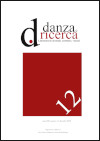From philology to theatrability, and back: the role of the dancing choir in classical plays at the Teatro Greco of Siracusa between 1914 and 1948
DOI :
https://doi.org/10.6092/issn.2036-1599/11808Résumé
In the open-air performances organised at the beginning of the 20th century at the Greek theatre of Syracuse, one can appreciate the transformation from a melodrama-like performance to a “rhythmic” performance, with the addition of a dancing chorus to the chorus of actors. Documents and pictures preserved by the National Institute for Ancient Drama Archive witness a remarkable moment of experimentation for modern dance and particularly for Dalcroze’s eurhythmics. During the 1930s, the dancing chorus becomes an element of aesthetic and emotional amplification, and performances are characterized by a “voiding” of the significance of the poetic word, in favour of a perceptive appreciation of the performances. The performance of Oresteia in 1948 contrasts with this approach, restoring full importance for the poetic text.
Téléchargements
Publiée
Comment citer
Numéro
Rubrique
Licence
© Giulia Bordignon 2020

Cette œuvre est sous licence Creative Commons Attribution - Pas d’Utilisation Commerciale 3.0 non transposé.




